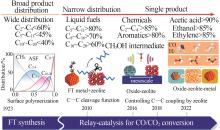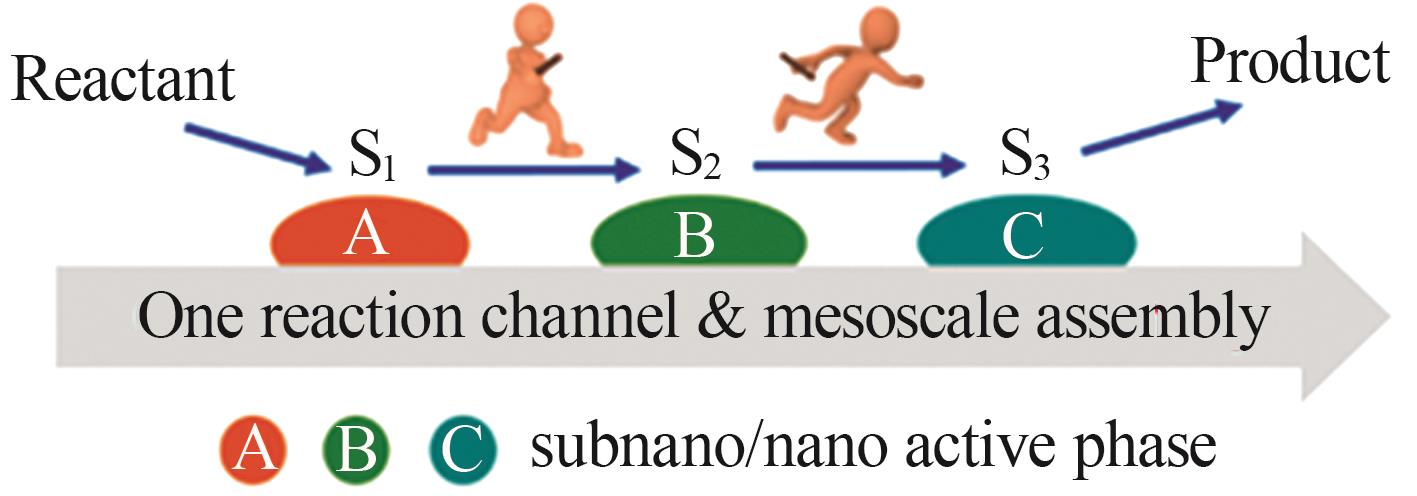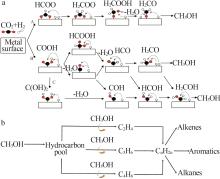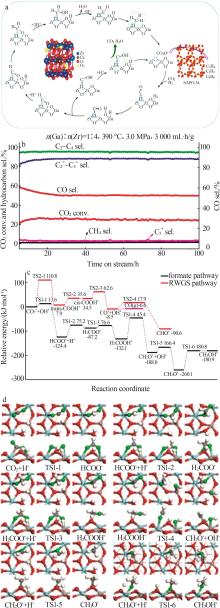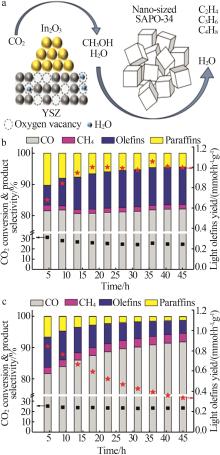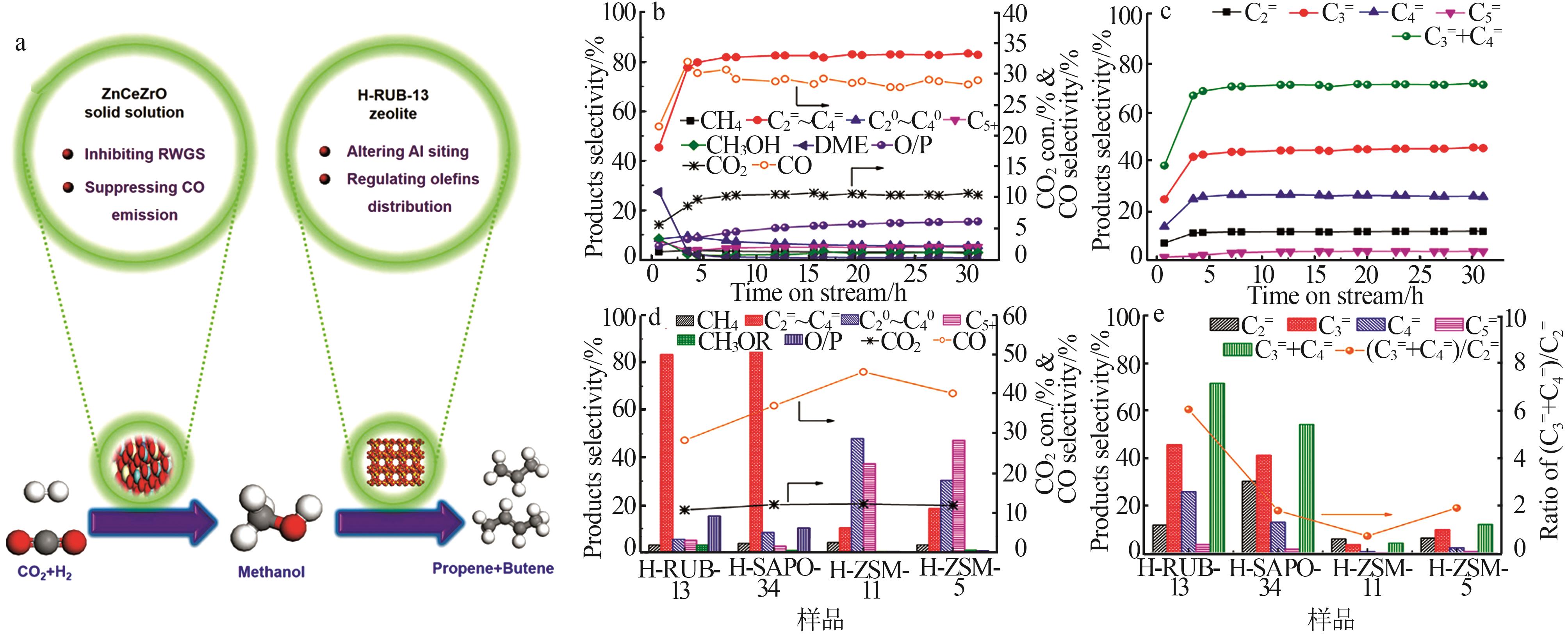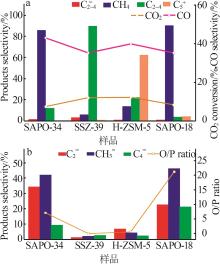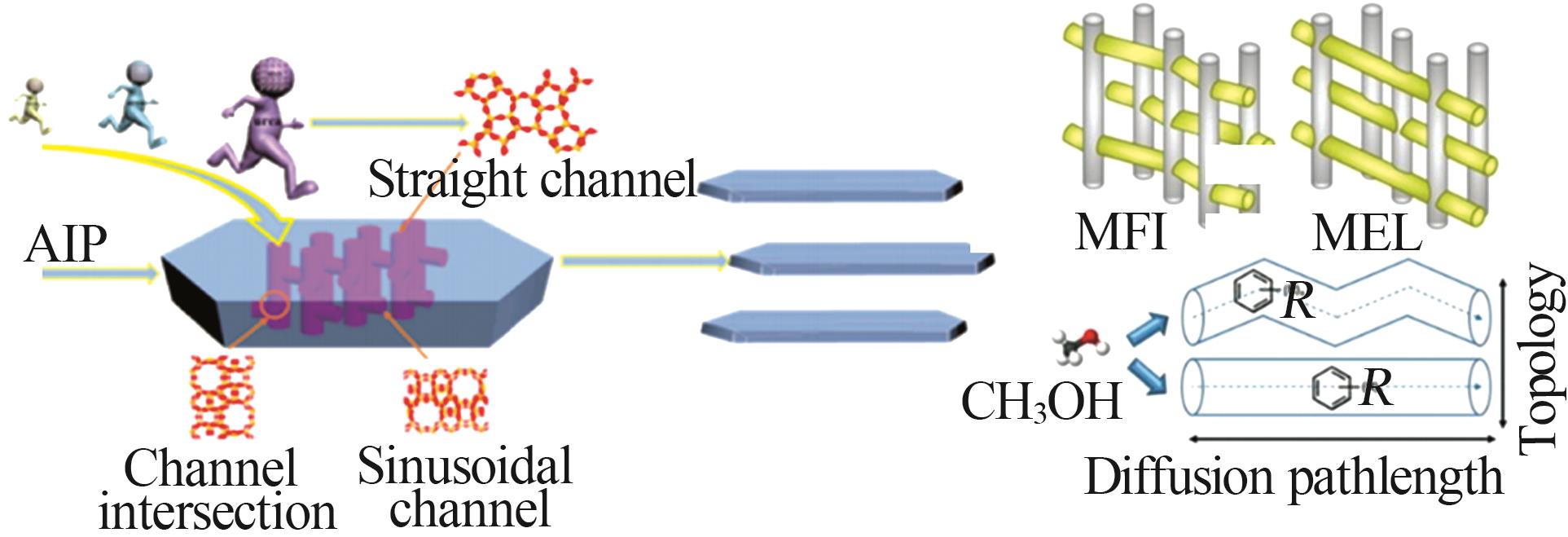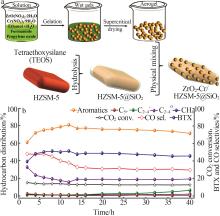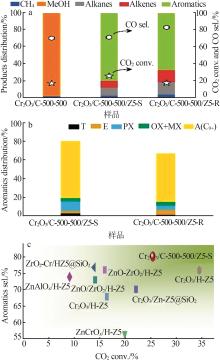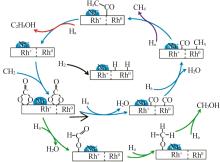Inorganic Chemicals Industry ›› 2024, Vol. 56 ›› Issue (11): 81-94.doi: 10.19964/j.issn.1006-4990.2024-0404
• Reviews and Special Topics • Previous Articles Next Articles
Research progress on catalysts for relay-catalysis of CO2 to prepare high value-added chemicals
FENG Qing( ), WANG Yansu, ZHOU Wei(
), WANG Yansu, ZHOU Wei( ), LIU Yang, SUN Yanmin, NAN Jun
), LIU Yang, SUN Yanmin, NAN Jun
- CNOOC Tianjin Chemical Research & Design Institute Co. ,Ltd. ,Tianjin 300131,China
-
Received:2024-08-20Online:2024-11-10Published:2024-11-27 -
Contact:ZHOU Wei E-mail:fengqing0707@126.com;362200922@163.com
CLC Number:
Cite this article
FENG Qing, WANG Yansu, ZHOU Wei, LIU Yang, SUN Yanmin, NAN Jun. Research progress on catalysts for relay-catalysis of CO2 to prepare high value-added chemicals[J]. Inorganic Chemicals Industry, 2024, 56(11): 81-94.
share this article
Table 1
Catalytic performance of spinel-structured metal oxides and SAPO-34 for CO2 hydrogenation[26]"
| 催化剂 | CO2转 化率/% | 选择性/% | CO选择性/% | |||||
|---|---|---|---|---|---|---|---|---|
| CH4 | C2=~C4= | C20~C40 | C5+ | CH3OH | DME | |||
| MgAl2O4 | 0.8 | 12.0 | 13.0 | 16.0 | 9.0 | 48 | 2 | 97 |
| MgGa2O4 | 7.8 | 0.9 | 0.1 | 0.0 | 0.0 | 65 | 34 | 87 |
| ZnAl2O4 | 12.0 | 0.6 | 0.1 | 0.1 | 0.0 | 84 | 15 | 69 |
| ZnGa2O4 | 9.8 | 0.2 | 0.0 | 0.0 | 0.0 | 98 | 0 | 68 |
| MgAl2O4/SAPO-34 | 1.1 | 9.0 | 65.0 | 18.0 | 8.0 | 0 | 0 | 96 |
| MgGa2O4/SAPO-34 | 8.7 | 1.9 | 65.0 | 25.0 | 8.3 | 0 | 0 | 82 |
| ZnAl2O4/SAPO-34 | 15.0 | 0.7 | 87.0 | 10.0 | 2.2 | 0 | 0 | 49 |
| ZnGa2O4/SAPO-34 | 13.0 | 1.0 | 86.0 | 11.0 | 2.0 | 0 | 0 | 46 |
Table 2
Performance parameters of dual functional catalysts for CO2 to low-carbon olefins"
| 催化剂 | 反应温度/℃ | 反应压强/MPa | 反应空速/(mL· g-1·h-1) | CO2转化率/% | C2=~C4=选择性/% | 反应时间/h |
|---|---|---|---|---|---|---|
| Zn0.5Ce0.2Zr1.8O4/H-RUB-13[ | 350 | 1 | 4 800 | 10.7 | 83.4 | 30 |
| In2O3-ZnZrO x /SAPO-34[ | 380 | 3 | 9 000 | 17 | 85 | 48 |
| In2O3/YSZ/SAPO-34[ | 420 | 3 | 4 000 | 30.3 | 10.8 | 45 |
ZnZrO x / SAPO-34[ | 375 | 2 | 3 000 | 23.9 | 72.4 | |
| Zr8Cd1O x /SAPO-18[ | 370 | 2.5 | 5 000 | 17.8 | 85.6 | 50 |
ZnZrO x / SAPO-18[ | 360 | 2 | 4 500 | 8.6 | 90.6 | 120 |
| GaZrO x /SAPO-34[ | 390 | 3 | 3 000 | 26.7 | 88.8 | 100 |
| ZnAl2O4/SAPO-34[ | 370 | 3 | 5 400 | 15 | 87 | |
| ZnCr2O4-ZSM-22[ | 360 | 5 | 1 200 | 21.9 | 24(乙烯选择性) | 60 |
Table 3
Effect of HZSM-5 with different morphologies tandem with different kinds of metal catalysts on catalytic performance of CO2 hydrogenation to aromatics[41]"
| 催化剂 | CO2 转化率/% | CO 选择性/% | 加氢产物的选择性/% | |||||||||
|---|---|---|---|---|---|---|---|---|---|---|---|---|
| C1~2 | C3 | C4 | C5+ | Ba | Tb | Xc | C9+ | BTX | Arod | |||
| ZnZr7O(500)-片状Z5 | 17.2 | 31.4 | 14.1 | 18.1 | 14.6 | 1.3 | 0.7 | 4.9 | 41.1 | 5.1 | 46.7 | 51.8 |
| ZnZr7O(500)-空心Z5 | 14.1 | 40.3 | 18.3 | 17.8 | 29.1 | 2.8 | 0.5 | 2.5 | 23.3 | 5.7 | 26.3 | 32.0 |
| ZnZr7O(500)-球形Z5 | 10.8 | 61.6 | 15.4 | 13.2 | 26.6 | 3.6 | 0.7 | 2.4 | 17.0 | 21.0 | 20.1 | 41.1 |
| ZnZr7O(500)-链状Z5 | 13.5 | 60.5 | 18.0 | 14.8 | 25.7 | 7.2 | 0.7 | 2.0 | 17.2 | 14.4 | 19.9 | 34.3 |
| In2O3-片状Z5 | 24.9 | 43.8 | 30.6 | 16.2 | 15.2 | 6.8 | 0.6 | 1.8 | 14.8 | 14.0 | 17.2 | 31.2 |
| Cu-ZnO-Al2O3-片状Z5 | 34.5 | 84.3 | 43.2 | 10.7 | 30.1 | 4.0 | 0.1 | 0.3 | 0.4 | 6.2 | 0.8 | 7.0 |
| 1 | The Global Carbon Budget Office.Global carbon budget 2023[R].London:Earth System Science Data,2023. |
| 2 | 李自琴,王康洲,高新华,等.CO2加氢制高碳α-烯烃Fe基催化剂研究进展[J].低碳化学与化工,2023,48(3):11-21. |
| LI Ziqin, WANG Kangzhou, GAO Xinhua,et al.Research progress on Fe-based catalysts for CO2 hydrogenation to high carbon α-olefins[J].Low-carbon Chemistry and Chemical Engineering,2023,48(3):11-21. | |
| 3 | ZHANG Wei, YANG Yu, LI Yunxin,et al.Recent progress on integrated CO2 capture and electrochemical upgrading[J].Materials Today Catalysis,2023,2:100006. |
| 4 | SU Junjie, LIU Chang, LIU Songlin,et al.High conversion of syngas to ethene and propene on bifunctional catalysts via the tailoring of SAPO zeolite structure[J].Cell Reports Physical Science,2021,2(1):100290. |
| 5 | 邵斌,孙哲毅,章云,等.二氧化碳转化为合成气及高附加值产品的研究进展[J].化工进展,2022,41(3):1136-1151. |
| SHAO Bin, SUN Zheyi, ZHANG Yun,et al.Recent progresses in CO2 to syngas and high value-added products[J].Chemical Industry and Engineering Progress,2022,41(3):1136-1151. | |
| 6 | 成康,张庆红,康金灿,等.二氧化碳直接制备高值化学品中的接力催化方法[J].中国科学:化学,2020,50(7):743-755. |
| CHENG Kang, ZHANG Qinghong, KANG Jincan,et al.Relay catalysis in the direct conversion of carbon dioxide to high-value chemicals[J].Scientia Sinica Chimica,2020,50(7):743-755. | |
| 7 | 郝金辉,施伟东.过渡金属(Mo,Fe,Co和Ni)基催化剂在电催化还原二氧化碳还原中应用[J].催化学报,2018,39(7):1157-1166. |
| HAO Jinhui, SHI Weidong.Transition metal(Mo,Fe,Co,and Ni)-based catalysts for electrochemical CO2 reduction[J].Chinese Journal of Catalysis,2018,39(7):1157-1166. | |
| 8 | 王挺,章文文,毛庆,等.二氧化碳电还原制乙醇催化体系与材料研究进展[J].无机盐工业,2024,56(7):1-10,68. |
| WANG Ting, ZHANG Wenwen, MAO Qing,et al.Research progress of catalytic system and materials for electrocatalytic reduction of carbon dioxide to ethanol[J].Inorganic Chemicals Industry,2024,56(7):1-10,68. | |
| 9 | 华凯敏,刘晓放,魏百银,等.过渡金属催化CO2/H2参与的羰基化研究进展[J].物理化学学报,2021,37(5):141-156. |
| HUA Kaimin, LIU Xiaofang, WEI Baiyin,et al.Research progress regarding transition metal-catalyzed carbonylations with CO2/H2 [J].Acta Physico-Chimica Sinica,2021,37(5):141-156. | |
| 10 | JIAO Feng, LI Jinjing, PAN Xiulian,et al.Selective conversion of syngas to light olefins[J].Science,2016,351(6277):1065-1068. |
| 11 | LIU Xiaoliang, WANG Mengheng, ZHOU Cheng,et al.Selective transformation of carbon dioxide into lower olefins with a bifunctional catalyst composed of ZnGa2O4 and SAPO-34[J].Chemical Communications,2018,54(2):140-143. |
| 12 | CHENG Kang, LI Yubing, KANG Jincan,et al.Selectivity control by relay catalysis in CO and CO2 hydrogenation to multicarbon compounds[J].Accounts of Chemical Research,2024,57(5):714-725. |
| 13 | MARTÍN N, CIRUJANO F G.Multifunctional heterogeneous catalysts for the tandem CO2 hydrogenation-Fischer Tropsch synthesis of gasoline[J].Journal of CO2 Utilization,2022,65:102176. |
| 14 | WANG Shunwu, WU Tijun, LIN Jun,et al.FeK on 3D graphene-zeolite tandem catalyst with high efficiency and versatility in direct CO2 conversion to aromatics[J].ACS Sustainable Chemistry & Engineering,2019,7(21):17825-17833. |
| 15 | ZHANG Chundong, HU Kehao, CHEN Xixi,et al.Direct hydrogenation of CO2 into valuable aromatics over K/Fe-Cu-Al @HZSM-5 tandem catalysts:Effects of zeolite surface acidity on aromatics formation[J].Fuel Processing Technology,2023,248:107824. |
| 16 | BURK M J, LEE J R, MARTINEZ J P.A versatile tandem catalysis procedure for the preparation of novel amino acids and peptides[J].Journal of the American Chemical Society,1994,116(23):10847-10848. |
| 17 | BALEMA V P, HEY-HAWKINS E.Die CuCl-katalysierte reaktion von trimethylsilyl(t-butyl)chlorphosphan mit dimethylzirconocen:Ein beispiel der tandem-katalyse[J].Zeitschrift Für Anorganische und Allgemeine Chemie,1996,622(12):2053- 2056. |
| 18 | 李永恒,吴冲冲,王文波,等.CO2催化制备高附加值多碳含氧化合物的研究进展[J].燃料化学学报(中英文),2024,52(4):496-511. |
| LI Yongheng, WU Chongchong, WANG Wenbo,et al.Research progress on CO2 catalytic conversion to value-added oxygenates[J].Journal of Fuel Chemistry and Technology,2024,52(4):496-511. | |
| 19 | 王晓星,段永鸿,张俊峰,等.串联催化剂上CO2催化转化制备高附加值烃类研究进展[J].燃料化学学报,2022,50(5):538-563. |
| WANG Xiaoxing, DUAN Yonghong, ZHANG Junfeng,et al.Catalytic conversion of CO2 into high value-added hydrocarbons over tandem catalyst[J].Journal of Fuel Chemistry and Technology,2022,50(5):538-563. | |
| 20 | PODROJKOVÁ N, SANS V, ORIŇAK A,et al.Recent developments in the modelling of heterogeneous catalysts for CO2 conversion to chemicals[J].ChemCatChem,2020,12(7):1802-1825. |
| 21 | SHARMA P, SEBASTIAN J, GHOSH S,et al.Recent advances in hydrogenation of CO2 into hydrocarbons via methanol intermediate over heterogeneous catalysts[J].Catalysis Science & Technology,2021,11(5):1665-1697. |
| 22 | CHIU H H, YU B Y.Synthesis of green light olefins from direct hydrogenation of CO2.PartⅡ:Detailed process design and optimization[J].Journal of the Taiwan Institute of Chemical Engineers,2024,155:105287. |
| 23 | BARRIOS A J, PERON D V, CHAKKINGAL A,et al.Efficient promoters and reaction paths in the CO2 hydrogenation to light olefins over zirconia-supported iron catalysts[J].ACS Catalysis,2022,12(5):3211-3225. |
| 24 | CHERNYAK S A, CORDA M, MARINOVA M,et al.Decisive influence of SAPO-34 zeolite on light olefin selectivity in methanol-meditated CO2 hydrogenation over metal oxide-zeolite catalysts[J].ACS Catalysis,2023,13(22):14627-14638. |
| 25 | LI Jian, YU Tie, MIAO Dengyun,et al.Carbon dioxide hydrogenation to light olefins over ZnO-Y2O3 and SAPO-34 bifunctional catalysts[J].Catalysis Communications,2019,129:105711. |
| 26 | LIU Xiaoliang, WANG Mengheng, YIN Haoren,et al.Tandem catalysis for hydrogenation of CO and CO2 to lower olefins with bifunctional catalysts composed of spinel oxide and SAPO-34[J].ACS Catalysis,2020,10(15):8303-8314. |
| 27 | ZHANG Peng, MA Lixuan, MENG Fanhui,et al.Boosting CO2 hydrogenation performance for light olefin synthesis over GaZrO x combined with SAPO-34[J].Applied Catalysis B:Environmental,2022,305:121042. |
| 28 | KIM S, JHAVERI C A, SASMAZ E.Impact of yttria-stabilized zirconia on direct CO2 hydrogenation to light olefins over a tandem catalyst composed of In2O3/YSZ and SAPO-34[J].Energy & Fuels,2023,37(10):7361-7371. |
| 29 | GAO Peng, DANG Shanshan, LI Shenggang,et al.Direct production of lower olefins from CO2 conversion via bifunctional cataly- sis[J].ACS Catalysis,2018,8(1):571-578. |
| 30 | WANG Sen, WANG Pengfei, QIN Zhangfeng,et al.Enhancement of light olefin production in CO2 hydrogenation over In2O3-based oxide and SAPO-34 composite[J].Journal of Catalysis,2020,391:459-470. |
| 31 | WANG Sen, ZHANG Li, ZHANG Wenyu,et al.Selective conversion of CO2 into propene and butene[J].Chem,2020,6(12):3344-3363. |
| 32 | 杨浪浪,孟凡会,张鹏,等.ZrCdO x /SAPO-18双功能催化剂催化CO2加氢合成低碳烯烃性能[J].无机化学学报,2021,37(3):448-456. |
| YANG Langlang, MENG Fanhui, ZHANG Peng,et al.Catalytic performance for CO2 hydrogenation to light olefins over ZrCdO x /SAPO-18 bifunctional catalyst[J].Chinese Journal of Inorganic Chemistry,2021,37(3):448-456. | |
| 33 | 陈思宇,王集杰,李灿.ZnZrO x /SAPO-18催化剂上CO2加氢制低碳烯烃[J].石油化工,2023,52(8):1031-1038. |
| CHEN Siyu, WANG Jijie, LI Can.Hydrogenation of CO2 to light olefins on ZnZrO x /SAPO-18 catalyst[J].Petrochemical Technology,2023,52(8):1031-1038. | |
| 34 | SHI Y, GAO W, WANG G,et al.Direct conversion of CO2 to ethylene by bifunctional ZnCr2O4-ZSM-22 catalyst[J].Materials Today Chemistry,2023,32:101654. |
| 35 | DANG Shanshan, LI Shenggang, YANG Chengguang,et al.Selective transformation of CO2 and H2 into lower olefins over In2O3-ZnZrO x /SAPO-34 bifunctional catalysts[J].ChemSusChem,2019,12(15):3582-3591. |
| 36 | PORTILLO A, PARRA O, EREÑA J,et al.Effect of water and methanol concentration in the feed on the deactivation of In2O3-ZrO2/SAPO-34 catalyst in the conversion of CO2/CO to olefins by hydrogenation[J].Fuel,2023,346:128298. |
| 37 | PORTILLO A, PARRA O, AGUAYO A T,et al.Kinetic model for the direct conversion of CO2/CO into light olefins over an In2O3-ZrO2/SAPO-34 tandem catalyst[J].ACS Sustainable Chemistry & Engineering,2024,12(4):1616-1624. |
| 38 | ZHANG Xinbao, ZHANG Anfeng, JIANG Xiao,et al.Utilization of CO2 for aromatics production over ZnO/ZrO2-ZSM-5 tandem catalyst[J].Journal of CO2 Utilization,2019,29:140-145. |
| 39 | TIAN Haifeng, JIAO Jiapeng, ZHA Fei,et al.Hydrogenation of CO2 into aromatics over ZnZrO-Zn/HZSM-5 composite catalysts derived from ZIF-8[J].Catalysis Science & Technology,2022,12(3):799-811. |
| 40 | WANG Yang, TAN Li, TAN Minghui,et al.Rationally designing bifunctional catalysts as an efficient strategy to boost CO2 hydrogenation producing value-added aromatics[J].ACS Catalysis,2019,9(2):895-901. |
| 41 | TIAN Haifeng, HE Huanhuan, JIAO Jiapeng,et al.Tandem catalysts composed of different morphology HZSM-5 and metal oxides for CO2 hydrogenation to aromatics[J].Fuel,2022,314:123119. |
| 42 | ZHOU Cheng, SHI Jiaqing, ZHOU Wei,et al.Highly active ZnO-ZrO2 aerogels integrated with H-ZSM-5 for aromatics synthesis from carbon dioxide[J].ACS Catalysis,2020,10(1):302-310. |
| 43 | ZHANG Lijun, GAO Weizhe, WANG Fan,et al.Highly selective synthesis of light aromatics from CO2 by chromium-doped ZrO2 aerogels in tandem with HZSM-5@SiO2 catalyst[J].Applied Catalysis B:Environmental,2023,328:122535. |
| 44 | WANG Wenhang, HE Ruosong, WANG Yang,et al.Boosting methanol-mediated CO2 hydrogenation into aromatics by synergistically tailoring oxygen vacancy and acid site properties of multifunctional catalyst[J].Chemistry-A European Journal,2023,29(40):2301135. |
| 45 | HE Yiming, MÜLLER F H, PALKOVITS R,et al.Tandem catalysis for CO2 conversion to higher alcohols:A review[J].Applied Catalysis B:Environment and Energy,2024,345:123663. |
| 46 | 张广宇,赵健,孙峰,等.CO2催化转化制碳酸丙烯酯研究进展:催化剂设计、性能与反应机理[J].化工进展,2022,41(S1):177-189. |
| ZHANG Guangyu, ZHAO Jian, SUN Feng,et al.Recent advances on catalytic conversion of CO2 into propylene carbonate:Catalyst design,performance and reaction mechanism[J].Chemical Industry and Engineering Progress,2022,41(S1):177-189. | |
| 47 | 朱有财,丁欣欣,孙莉,等.CO2/C2H4耦合制备丙烯酸及其衍生物的研究进展[J].有机化学,2022,42(4):965-977. |
| ZHU Youcai, DING Xinxin, SUN Li,et al.Advances in the production of acrylic acid and its derivatives by CO2/C2H4 coupling[J].Chinese Journal of Organic Chemistry,2022,42(4):965-977. | |
| 48 | 金湘元,张礼兵,孙晓甫,等.单原子催化剂在电催化还原CO2领域的应用[J].高等学校化学学报,2022,43(5):5-24. |
| JIN Xiangyuan, ZHANG Libing, SUN Xiaofu,et al.Electrocatalytic CO2 reduction over single-atom catalysts[J].Chemical Journal of Chinese Universities,2022,43(5):5-24. | |
| 49 | ZHANG Fuyong, ZHOU Wei, XIONG Xuewei,et al.Selective hydrogenation of CO2 to ethanol over sodium-modified rhodium nanoparticles embedded in zeolite silicalite-1[J].The Journal of Physical Chemistry C,2021,125(44):24429-24439. |
| 50 | WANG Guishuo, LUO Ran, YANG Chengsheng,et al.Active sites in CO2 hydrogenation over confined VO x -Rh catalysts[J].Science China Chemistry,2019,62(12):1710-1719. |
| 51 | DING Liping, SHI Taotao, GU Jing,et al.CO2 hydrogenation to ethanol over Cu@Na-beta[J].Chem,2020,6(10):2673-2689. |
| 52 | FAN Linhui, WANG Yuezhao, ZHAI Xiaohan,et al.Production of oxygenates from CH4/CO2 plasma reaction assisted by Ni/HZSM-5 catalyst[J].Plasma Chemistry and Plasma Processing,2023,43(6):1979-1998. |
| 53 | XIE Zhenhua, XU Yuanguo, XIE Meng,et al.Reactions of CO2 and ethane enable CO bond insertion for production of C3 oxygenates[J].Nature Communications,2020,11:1887. |
| 54 | XIE Zhenhua, GUO Haoyue, HUANG Erwei,et al.Catalytic tandem CO2-ethane reactions and hydroformylation for C3 oxygenate production[J].ACS Catalysis,2022,12(14):8279-8290. |
| 55 | BISWAS A N, XIE Zhenhua, XIA Rong,et al.Tandem electrocatalytic-thermocatalytic reaction scheme for CO2 conversion to C3 oxygenates[J].ACS Energy Letters,2022,7(9):2904-2910. |
| 56 | BISWAS A N, WINTER L R, LOENDERS B,et al.Oxygenate production from plasma-activated reaction of CO2 and ethane[J].ACS Energy Letters,2022,7(1):236-241. |
| [1] | YAN Xin, LIU Hailu, LIU Baolin, LIU Yi, LIU Yanyang. Research on key technologies and mechanisms of green nano calcium carbonate production [J]. Inorganic Chemicals Industry, 2025, 57(1): 71-76. |
| [2] | ZHAN Sijin, LIU Shike, LIU Fei, YAO Mengqin, CAO Jianxin. Study on preparation and catalytic performance of ZnO-CeO2 [J]. Inorganic Chemicals Industry, 2024, 56(3): 137-143. |
| [3] | REN Qixia, YANG Kun, LIU Fei, YAO Mengqin, CAO Jianxin. Effect of promoter on physicochemical properties and catalytic performance of ZnO/ZrO2 [J]. Inorganic Chemicals Industry, 2024, 56(3): 144-154. |
| [4] | YANG Kun, REN Qixia, DONG Yonggang, LIU Fei, YAO Mengqin, CAO Jianxin. Effect of calcination temperature on catalytic performance of ZnGaZrO x /SAPO-34 [J]. Inorganic Chemicals Industry, 2024, 56(2): 136-145. |
| [5] | LI Yang, LOU Feijian, SUI Xin, LI Keyan, LIU Fei, GUO Xinwen. Preparation of amine-functionalized fumed SiO2 materials and their performance for CO2 adsorption [J]. Inorganic Chemicals Industry, 2024, 56(2): 38-43. |
| [6] | HOU Zhanggui, WU Chongchong, ZHANG Siran. Research progress of CO2 conversion via Reverse Water-Gas Shift reaction [J]. Inorganic Chemicals Industry, 2024, 56(11): 105-115. |
| [7] | CHEN Xu, YANG Gang, LI Haitao. Study on preparation of multistage pore nano-SAPO-34 molecular sieves and its methanol to olefin performance [J]. Inorganic Chemicals Industry, 2024, 56(1): 134-140. |
| [8] | CHANG Chengbing, LIU Shengyu, ZHANG Lei, YANG Zhichao, GUO Jianying, LI Bao. Experimental study on carbon dioxide sequestration by wet carbonation of calcium silicate minerals [J]. Inorganic Chemicals Industry, 2023, 55(9): 57-65. |
| [9] | ZHAO Yan, HAO Xuewei, SHI Hainan, LI Jiahui, LI Keyan, GUO Xinwen. Study on photocatalytic CO2 reduction performance of Cu-doped TiO2/PCN heterojunction [J]. Inorganic Chemicals Industry, 2023, 55(8): 21-27. |
| [10] | SONG Zhijia, WANG Suisui, KUANG Qin. Hollow Cu-doped TiO2 for enhancing photocatalytic CO2 reduction performance [J]. Inorganic Chemicals Industry, 2023, 55(8): 45-50. |
| [11] | GUI Changqing, WANG Yajing, LING Changjian, WANG Huaiyou, TANG Zhongfeng. Research progress of preparation and modification of MgO-based CO2 adsorbents [J]. Inorganic Chemicals Industry, 2023, 55(8): 77-83. |
| [12] | WANG Jianfang, YANG Heping, LI Kaibin, CONG Shiqiang, ZHANG Bojie, GUO Shan. Study on preparation of C3N4/MnCo2S4 composites and their capacitive properties [J]. Inorganic Chemicals Industry, 2023, 55(7): 70-74. |
| [13] | LI Songhong,ZHOU Songhua,ZHAO Aiming,DONG Wenyan,JIANG Chunyan,CAO Yang,AO Xianquan. Study on catalytic gasification reaction of distillers′grains under H2O/CO2 atmosphere [J]. Inorganic Chemicals Industry, 2023, 55(2): 132-140. |
| [14] | YANG Tinglong,WANG Fuzhong,LIU Fei. Study on sulfur poisoning of zirconium-based bimetallic oxides catalyst [J]. Inorganic Chemicals Industry, 2023, 55(1): 151-158. |
| [15] | WENG Dingsong,WANG Zhenghao,CHEN Liang,YIN Rentao,XIAO Haibing,LIU Weizao,LIANG Bin,LUO Dongmei. Serpentine coupled with copperas to enrich magnesium solution for simultaneous CO2 mineralization and nickel recovery [J]. Inorganic Chemicals Industry, 2023, 55(1): 93-99. |
| Viewed | ||||||
|
Full text |
|
|||||
|
Abstract |
|
|||||
|
||
